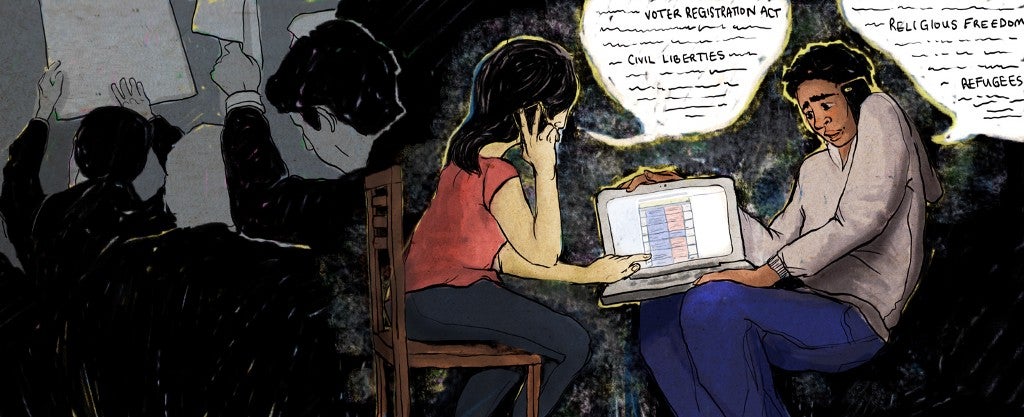It’s not as charmingly industrious as churning out mimeographs for a grassroots feminist protest in the ‘70s, nor as futuristic as Skyping your way through Syria’s rebel opposition operations center. But it seems to be the most efficient. Move over, Slacktivism; the call to arms for shellshocked Trump opponents is a shareable spreadsheet in Google Drive. It’s not fancy. In fact, it couldn’t be any more low-tech and still exist on the internet. Yet it’s become the perfect populist platform for mobilizing resistance to the 2016 election, and simultaneously attempting to answer the question, “Trump got elected. Now what?”
The top dog among them is “We’re His Problem Now,” an impressively thorough call sheet listing the phone number of every U.S. representative, senator and party leader with an accompanying script for every issue. When someone shared it with Fast Company writer Kelsey Campbell-Dollaghan, it answered a question she’d been mulling over. “Multiple people shared ‘We’re His Problem Now’ with me, just a day after I had wondered why there wasn’t a good web application or well-designed site to help people call their representatives,” she writes. “It turned out, no one needed a fancy tool: They just needed a damn spreadsheet.”
When it comes to technology and crises, messages have a knack for finding the right mediums, in spite of their limitations. For instance, in 2014 pro-democracy protesters in Hong Kong messaged each other on mobile phones via an app called FireChat largely because it could operate on Bluetooth when cell networks were down. And Facebook, YouTube and Twitter were all pivotal mediums for spreading the messages of the Arab Spring in 2012. Google Drive isn’t as sleek or sexy as those other social platforms (all of which were considered hot at one time or another), but neither is political organizing, so it’s perfect for the dull work of building resources for two obvious reasons: Anyone can use it, and anyone can share it.
Google Docs (now, like Google Sheets, housed within Google Drive) began in 2005 as a text-based web editor called Writerly, which was created by engineer Sam Schillace and admittedly hacked together from word-processing software and Javascript in browsers that allowed for editable content. The collaboration aspect came almost by accident.
“Collaboration on documents wasn’t really a thing we thought of as a first-order goal, we just thought [locking a document so others can’t accidentally overwrite your edits] was kind of gross and thought that it should feel natural if you were working on something with someone else,” Schillace told The Verge in 2013. The designers essentially bet, he said, that “users would want speed, convenience, and collaborative features” over “richer functionality,” meaning features like pagination and margins were considered too fancy initially. (They would be added later when it was clear enough people still wanted them.) Google bought Writerly the next year, and soon, 90 percent of the company was using it internally as Google Docs.
It would take a minute, but that design gamble favoring maximum simplicity over all else made Google Docs perfect for organizing on the fly in a crisis. Some five years after its creation, Occupy Wall Street organizers used Google Docs to collaborate multiple movements across cities. Similarly, in 2013, Boston residents used Google Docs to offer complete strangers places to stay after the Marathon Bombing. And this summer, Google Docs became an activists’ tool again when hundreds of Asian Americans joined Christina Xu in writing an open letter in support of the Black Lives Matter movement.
Now, Trump protesters are quickly creating and compiling resource-rich documents that have been shared thousands of times in hopes of preserving numerous social services and progressive policies they worry Trump might undo. For instance…
- There’s a Google Sheet to find out if your state rep has publicly opposed Steve Bannon’s appointment.
- There’s the “Doc of All Docs,” which includes links to retailers selling Ivanka Trump’s clothing line, trans relief resources, Twitter activism hashtags, donation resources and even guides for how to talk about Trump with loved ones.
- There’s the “Oh Crap! What Now? Survival Guide,” which covers everything from securing mental health help to locking in federally funded resources that could be killed under Trump such as low-interest loans for low-income homeowners, SNAP funding and student-loan repayment assistance. It has been so popular it had to be moved to a WordPress site four days after its creation.
- There’s a doc for how to prep for January’s inauguration, arranged by demographic.
- There’s the Stay Nasty America doc, which lists resources by state, as well as a running tally of events by state where you can donate to your local Planned Parenthood fund-raiser or attend an immigrant policy organizing conference.
- There’s even a satirical Google Doc called “National Registry of White Males,” meant to illustrate the fact that it’s white men who pose the greatest domestic threat to security. Users are encouraged to register every white male they can think of in response the idea of creating a national registry of immigrants or Muslims.
Kara Waite, author and shepherd of “We’re His Problem Now,” told Fast Company she “didn’t anticipate the demand for a simple tool like this.” She made it at a friend’s request and was surprised it took off. “I thought maybe two people would look at it,” she said. “But it’s been shared more than 10,000 times from my post and more from other friends’ posts.”
A Google Doc isn’t perfect. Fast Company notes that if anyone can edit it, anyone can alter it, potentially inviting all kinds of problematic trolling or hacking (though nothing like that has been reported to date). But in a world where you can easily toss up a website on any number of free blogging platforms and make it look pretty with very little skill, there’s also something mundanely romantic about plain text, in clear language, telling people, with no fanfare, exactly what to do and how to do it.

